"January Thunder" How the German 18th Army was driven back from Leningrad
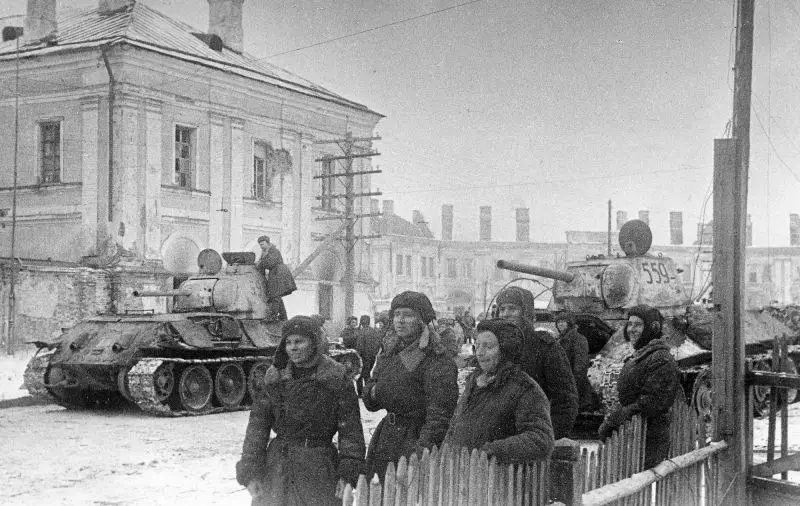
Tankers of the 222nd separate tank regiment of the 2nd shock army of the Leningrad Front on Karl Marx Avenue in liberated Kingisepp. February 1, 1944
Troops of the Leningrad, Volkhov and 2nd Baltic Fronts in cooperation with the forces of the Baltic fleet и Aviation long-range launched a strategic offensive with the goal of completely lifting the blockade of Leningrad, the liberation of the Leningrad region and the defeat of the German army group "North".
General situation
Despite the brutal defeats suffered in 1943, the Wehrmacht was still a dangerous enemy. During the 1944 campaign, the German Headquarters relied on defense, hoping with persistent and skillful defense to keep the Russians far to the east from the main centers of the German Empire and its allies.
The absence of a second front in Western Europe allowed the Germans to concentrate their main forces and means against the Red Army. The fighting that the Allies waged in Italy, in its significance and scope, could not claim to be a second front. All along the Eastern Front, the Germans tried to create a strong defense. The Wehrmacht was still a very skillful and dangerous enemy, constantly counterattacking, trying to improve the situation at the front.
The Red Army learned quickly and was already equal to the Germans in skill, and gained an advantage in terms of the number of personnel and equipment. Soviet industry surpassed German: “Magnitka defeated the Ruhr.”
In December 1943, the Soviet Headquarters decided to launch an offensive from Leningrad to the Black Sea during the winter campaign, with special attention to be paid to the flanks of the Soviet-German front. In the southern direction they planned to liberate Right Bank Ukraine (The battle for the liberation of Right Bank Ukraine) and Crimea, go to the state border in the spring.
On the northern wing, defeat Army Group North, completely lift the blockade of Leningrad and reach the borders of the Baltic republics. It was decided to launch a series of powerful successive strategic strikes. In order to break through enemy defenses, powerful groupings of troops were created. Each group received a pronounced shock character due to giving them tanks, artillery and aviation.
The main offensive strategic operations of 1944 were called “Stalin’s Ten Strikes.” The first of these was a strike in the Leningrad area. In early January, the Red Army began its offensive in Ukraine (How Konev's armies liberated Kirovograd), which diverted the attention of the Nazis. The actions of Soviet troops in the north took the enemy by surprise and did not give him the opportunity to quickly transfer troops from other sectors of the front.
A year earlier, in January 1943, troops of the Leningrad and Volkhov fronts (LF and VF), during the implementation of Operation Iskra, broke the blockade of Leningrad (Operation Spark). A railway line was built on a narrow section near Lake Ladoga, and trains with food, ammunition and fuel went to the city. But it was not possible to completely lift the blockade from Leningrad.
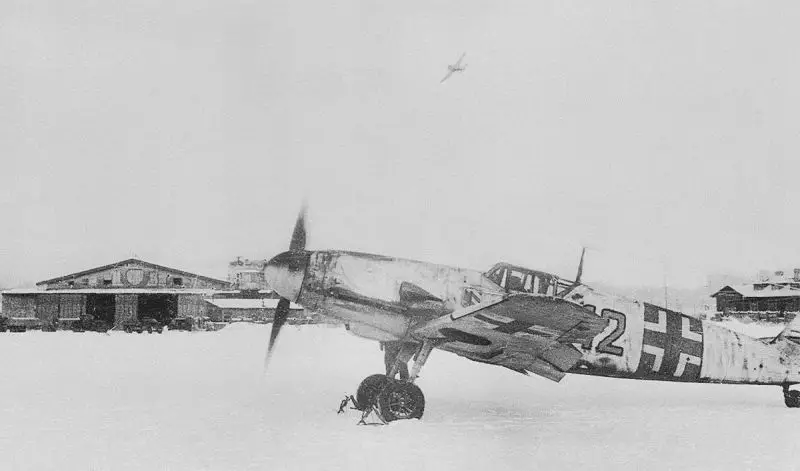
Messerschmitt Bf.109G-2 fighter from the 3rd squadron of the 54th fighter squadron (at the Krasnogvardeysk airfield (currently Gatchina). 1943
Plans of the Soviet command
In September 1943, the Military Councils of the Leningrad and Volkhov Fronts presented plans for a joint large-scale offensive to the Headquarters of the Supreme High Command. The LF Military Council proposed delivering the main blow with the 42nd Army from the Pulkovo area and the Primorsky operational group from the Oranienbaum bridgehead. The troops were supposed to unite in the Krasnoe Selo area. Then the troops of the 67th Army were to liberate Krasnogvardeysk and continue the offensive in the general direction towards Luga and Kingisepp.
The VF was supposed to deliver the main blow from the Novgorod region in the direction of Luga, where the front forces were supposed to link up with the forces of the LF. Thus, the troops of the Leningrad and Volkhov fronts were supposed to encircle and destroy the main forces of the German 18th Army. In the future, Soviet troops were to develop an offensive against Pskov and Ostrov.
Intelligence reported that German troops near Leningrad were soon planning to retreat to new defensive lines. Taking into account new intelligence data, the Leningrad, Volkhov and Northwestern fronts were instructed to be ready, if necessary, to immediately go on the offensive in order to pursue enemy forces. Taking into account the possibility of developments in this scenario, the Neva-1 plan was developed. Soviet troops were ready to immediately pursue the German troops. The Neva-2 plan was developed taking into account the fact that the Wehrmacht would continue to hold its positions near Leningrad.
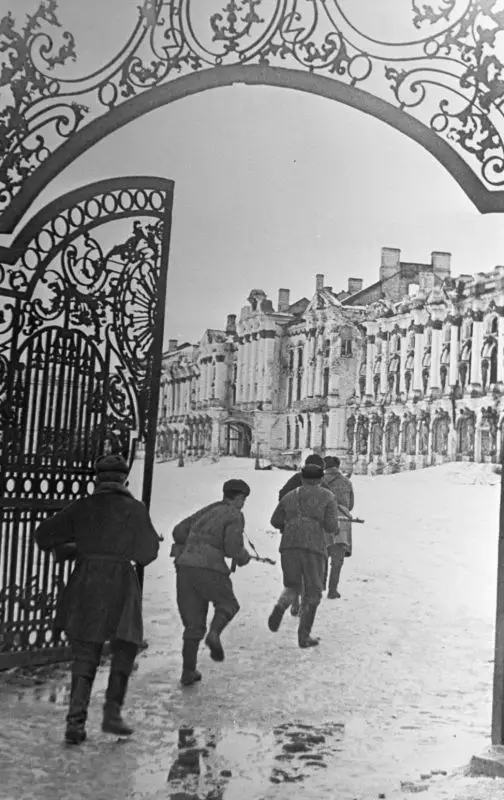
Soviet soldiers at the Grand Catherine Palace in liberated Pushkin
Together with the headquarters of the Leningrad and Volkhov fronts, plans for a larger-scale operation were prepared by the Supreme Command Headquarters and the General Staff. They planned to encircle and destroy the main forces of Army Group North. Taking into account the possible withdrawal of the 18th German Army in October 1943, it was decided to strike at the junction of the German army groups North and Center in order to cut off Nazi troops in the northwestern direction. The Baltic Front was supposed to advance in the Idritsa direction. The forces of the Kalinin Front advanced on Vitebsk, and then had to develop an offensive in the direction of Polotsk, Dvinsk and Riga. The Northwestern Front received the task of advancing in the direction of Dno - Pskov. The Volkhov Front was supposed to hit Novgorod, and then Luga.
Thus, Headquarters and the General Staff planned to destroy the main forces of Army Group North, finally release Leningrad, liberate the Leningrad region, Estonia and Latvia.
The troops of the Kalinin and Baltic fronts were unable to complete their tasks. On October 20, these fronts were transformed into the 1st and 2nd Baltic Fronts, and the North-Western Front was disbanded. The Baltic fronts held positions in the Vitebsk and Idritsa directions. Despite minor successes, these fronts were unable to create an advantageous operational position for the subsequent strategic offensive.
Therefore, it was decided to abandon the idea of a large-scale plan to encircle Army Group North. The Supreme High Command headquarters decided to deliver the main blow with the forces of the Leningrad and Volkhov fronts, since the plan for their offensive had already been developed. The headquarters decided that the defeat of the 18th Army and the final release of the blockade of Leningrad would irrevocably change the situation in the Baltic direction in favor of the Red Army.

The 2nd Baltic Front was also supposed to go on the offensive. The front received the task of defeating enemy forces in the Nevel area, developing an offensive towards Idritsa and north of Novosokolniki in order to cut off the enemy’s main communications and pin down the main forces of the 16th Army, preventing them from coming to the aid of the 18th Army. In the future, the troops of the 2nd Baltic Front were to advance in the direction of Sebezh and Opochka. In the event of a successful development of the offensive of the 2nd Baltic Front, the possibility arose of encircling the main forces of Army Group North and the rapid exit of Soviet troops to Estonia and Latvia.
Thus, at the first stage of the offensive, the forces of the VF and LF were to destroy the formations of the 18th Army, and the 2nd Baltic Front was to pin down the troops of the 16th Army and the operational reserves of Army Group North with their actions. If the first stage of the offensive was successful, the forces of all three Soviet fronts, attacking in the Narva, Pskov and Idritsa directions, were supposed to defeat the troops of the 16th German Army. After the liberation of the Leningrad region, conditions appeared for the liberation of the Baltic states.
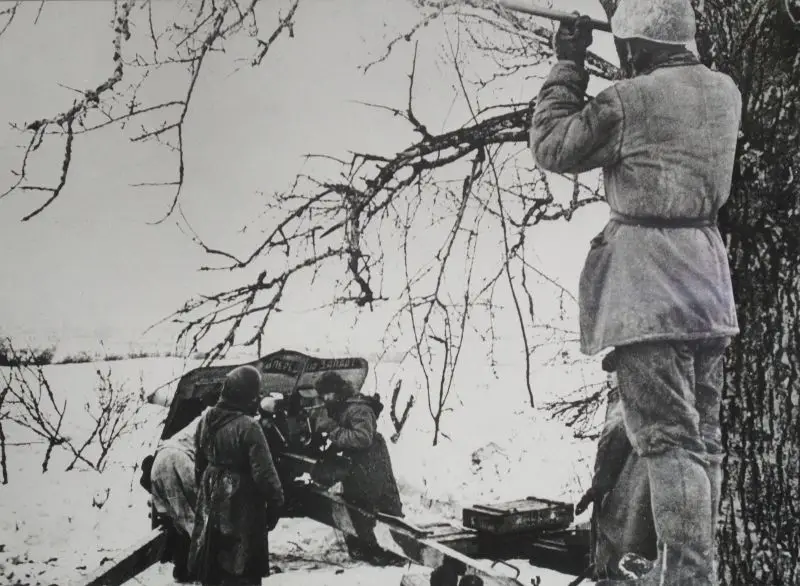
Crew of the Soviet 76-mm divisional gun F-22-USV in position on the Leningrad Front. Operation January Thunder. January 1944
Soviet forces
The defeat of Army Group North and the complete liberation of the Leningrad region was to be carried out by the LF troops under the command of Army General Leonid Govorov, the VF of Army General Kirill Meretskov and the 2nd Baltic Front of Army General Markian Popov. The forces of the Red Banner Baltic Fleet under Admiral Vladimir Tributs and Long-Range Aviation under the command of Air Marshal Alexander Golovanov were also involved in the operation.
The LF held the Oranienbaum bridgehead, positions around Leningrad from the Gulf of Finland to the Neva River, as well as along the southern coast of Lake Ladoga from Moscow Dubrovka to Gontovaya Lipka. The LF included the 2nd Shock Army, the 42nd and 67th Armies and the 13th Air Army. The front was also supported from the air by aircraft of the Leningrad Air Defense Army and Baltic Fleet aviation. In total, the LF had 30 rifle divisions, 3 rifle and 4 tank brigades and 3 fortified areas, as well as a significant number of other formations with a total number of more than 417 thousand people. The LF offensive was supported by units of the Baltic Fleet - about 90 thousand people.
The VF occupied the defense from Gontovaya Lipka to Lake Ilmen. The front included units of the 59th, 8th and 54th armies, and the 14th Air Army. The armies consisted of 22 rifle divisions, 6 rifle and 4 tank brigades, 14 tank and self-propelled artillery regiments and battalions, 2 fortified areas, as well as a large number of artillery, mortar and engineering units - a total of about 260 thousand soldiers and officers.
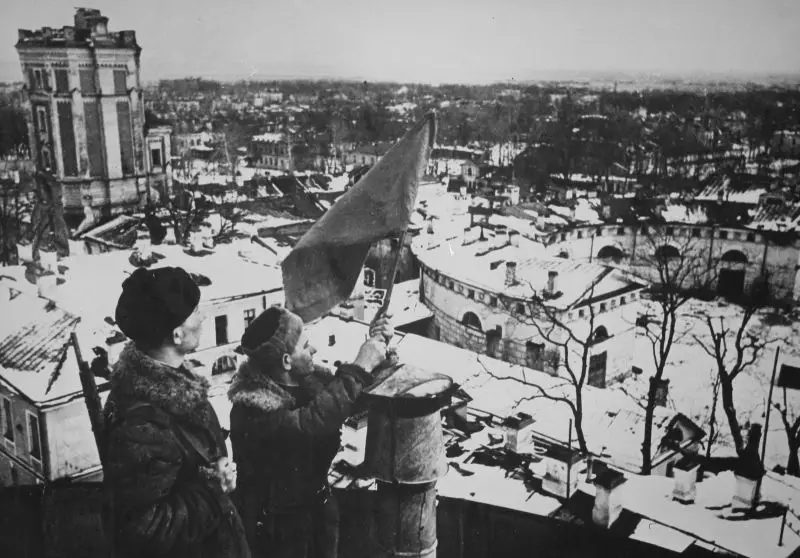
Soviet soldiers plant a red flag on the arch of the Lyceum in liberated Pushkin. January 24, 1944
The 2nd PF occupied positions on the line from Lake Ilmen to Lake Nescherda. The front included units of the 6th, 10th Guards, 1st, 3rd Shock and 22nd Armies, 15th Air Army. The armies of the 2nd Baltic Front consisted of 45 rifle divisions, 3 rifle and 4 tank brigades, 1 fortified area, as well as artillery and engineering units.
In total, the Soviet troops before the offensive numbered more than 1 million 250 thousand people (according to other sources, 900 thousand people), more than 20 thousand guns and mortars, over 1500 tanks and self-propelled guns, 1386 aircraft, including 330 long-range aviation aircraft. Also, the advance of the Red Army was supported by partisan formations. In the offensive area of the Leningrad Front alone, 13 partisan brigades operated, the number of which reached 35 thousand people.
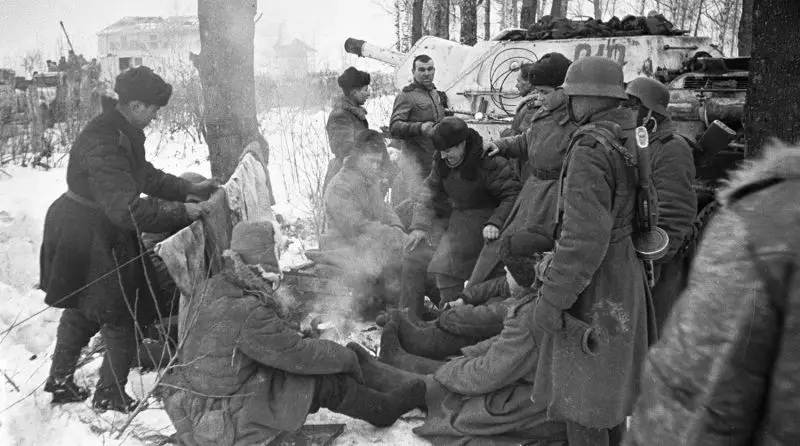
Soviet self-propelled gunners and infantrymen rest at a rest stop in Krasnoe Selo. Operation January Thunder. In the background on the right is a SU-122 self-propelled gun from the 1439th self-propelled artillery regiment. In the frame there are two Soviet machine gunners in German M-40 helmets
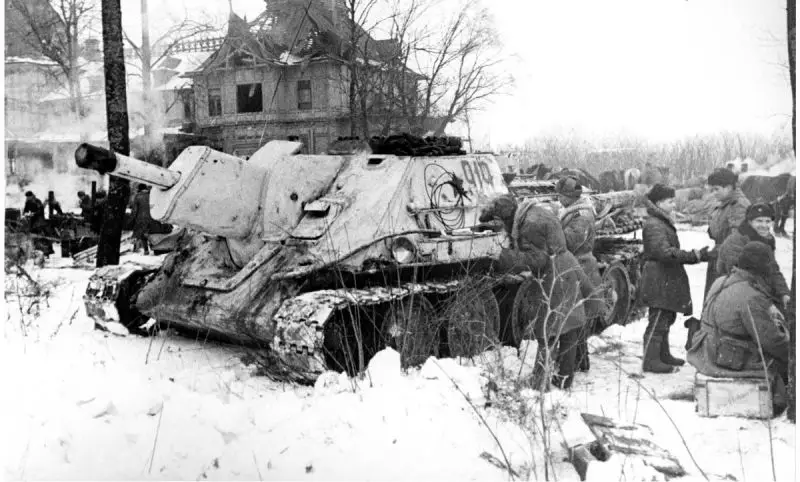
Soviet self-propelled gunners and infantrymen at a rest near the SU-122 self-propelled gun in Krasnoye Selo
German forces
The front line of German Army Group North remained unchanged for much of the war. The 18th Army still stood on the near approaches to Leningrad under the command of Cavalry General Georg Lindemann. It consisted of: 3rd SS Panzer Corps, 26th, 28th, 38th, 50th, 54th Army Corps (19 divisions and 3 brigades).
On the right flank of the 18th Army and the junction of Army Group North with Army Group Center was the 16th Army of Colonel General Christian Hansen. The 16th Army included: 1st, 2nd, 8th, 10th, 43rd Army Corps and 6th SS Corps (21 divisions and 1 brigade). Both armies numbered up to 500 thousand people. They were covered from the air by aircraft of the 1st Air Fleet under the command of General Kurt Pflugbeil (370 aircraft).
Leningrad was constantly subjected to artillery shelling. For the purpose of shelling the city, the German command formed two special artillery groups consisting of 75 batteries of heavy and 65 batteries of light artillery. The entire Army Group North numbered 741 thousand people (according to other sources, more than 600 thousand people), had more than 10 thousand mortar guns, 385 tanks and assault guns.
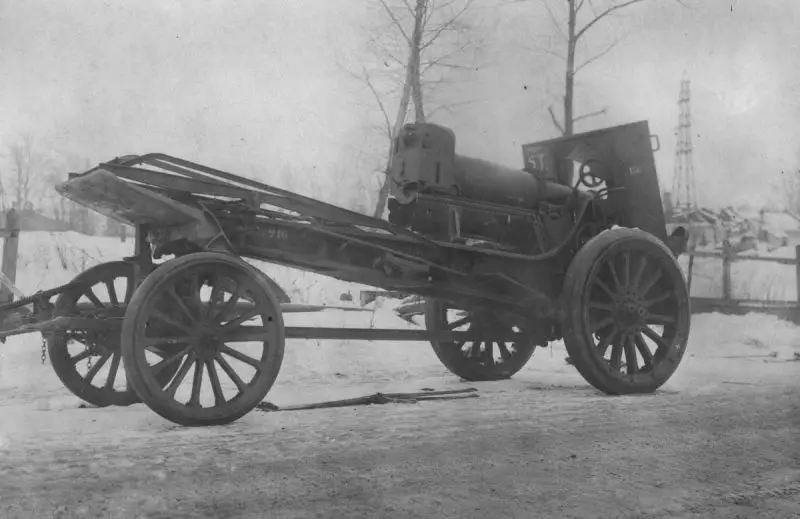
German 220-mm mortar Mrs.531(f), captured by Soviet units in Krasnoye Selo. This gun is a captured French 220-mm TR mortar of the 1916 model of the Schneider system. January 21, 1944
The command of Army Group North, due to the general deterioration of the situation on the Eastern Front, prepared a plan for retreat from Leningrad. The troops had to retreat to the powerful Panther line of defense. The line included two defense lines: the 1st ran along the banks of Lake Pskov, the Velikaya, Pskova and Cherekha rivers, the 2nd ran along the western bank of the Velikaya River and the Narova River to the Baltic Sea near Narva.
The retreat was to be carried out gradually, in several stages from mid-January to the spring of 1944. In the depths of the 18th Army's defense there were several intermediate defensive lines. However, the blockade of Leningrad was of great strategic importance for Berlin. It made it possible to pin down significant forces of the Red Army and the Baltic Fleet, close the approaches to the Baltic states and its ports and naval bases, maintain freedom of action of the German Navy in the Baltic and ensure sea communications with Finland and Sweden.
Hitler believed that the Red Army did not have enough strength to simultaneously continue the offensive in the southern direction and strike in the north. And the commander of the 18th Army, Lindemann, assured the Fuhrer that his troops would repel the enemy’s attack. Therefore, Army Group North received orders from Headquarters to maintain positions in the Leningrad area at any cost.
For two and a half years, the Nazis strengthened themselves very thoroughly. The Nazis created a powerful and well-equipped defense. The line of defense consisted of a system of strong resistance nodes and strongholds, which had fire communications and were located taking into account the characteristics of the wooded, swampy and lake terrain. The defense was especially powerful in the Pulkovo Heights area and north of Novgorod. There were not only machine-gun and gun emplacements here, but also reinforced concrete pillboxes, anti-tank ditches and gouges.
In addition, the wooded and swampy terrain helped the defending side. Soviet troops had to overcome many rivers, rivulets, streams, lakes and swamps. There were few dirt roads here, the railways were destroyed. The thaw made the operation even more difficult.
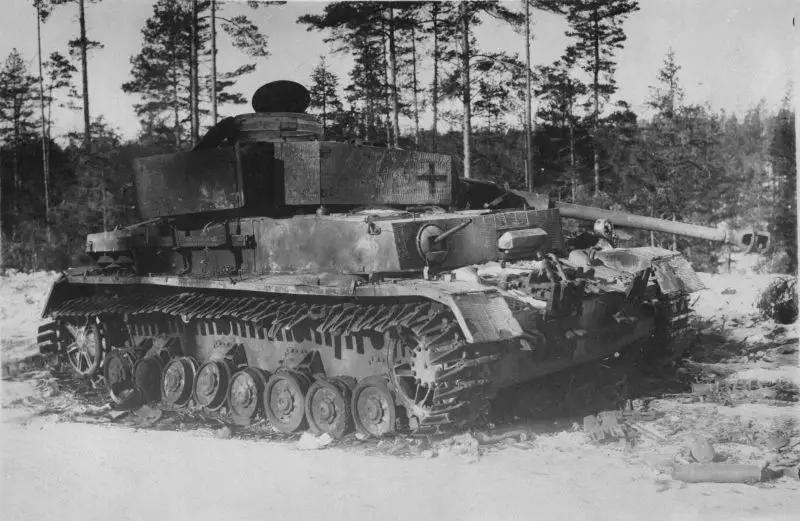
Founded during the operation "January Thunder" German tank PzKpfw IV
Krasnoselsko-Ropshinsky operation
On the eve of the offensive, Fedyuninsky’s 2nd Shock Army was transferred to the Oranienbaum bridgehead. The forces of the Baltic Fleet and transport aviation transferred 5 rifle divisions, 13 artillery regiments, one tank brigade, 2 tank regiments and one self-propelled gun regiment to the bridgehead before and during the operation.
On January 14, 1944, the 2nd Shock Army, with the forces of two rifle corps, launched an attack from the Oranienbaum bridgehead. On January 15, three rifle corps of Maslennikov’s 42nd Army went on the offensive from the Pulkovo region. Both armies attacked in the direction of Krasnoe Selo and Ropsha. Before the start of the offensive, sappers made passages in minefields and barbed wire barriers, and aviation and artillery struck defense centers and firing positions of German troops.
In the first days, the advance of Soviet troops was insignificant. It seemed that the previous attacks of the Soviet armies near Leningrad were being repeated. The Germans, relying on a well-prepared defense, offered fierce resistance and launched counterattacks at every opportunity. Also, Soviet troops faced skillful and stubborn resistance from selected Nazi formations. In particular, in the area of the Oranienbaum bridgehead, the defense was held by units of the 3rd SS Panzer Corps under the command of F. Steiner. It consisted of the 11th SS Panzergrenadier Division "Norland", the 9th and 10th Luftwaffe Field Divisions, the 4th Volunteer SS Panzergrenadier Brigade "Netherland" and one regiment of the SS police division.
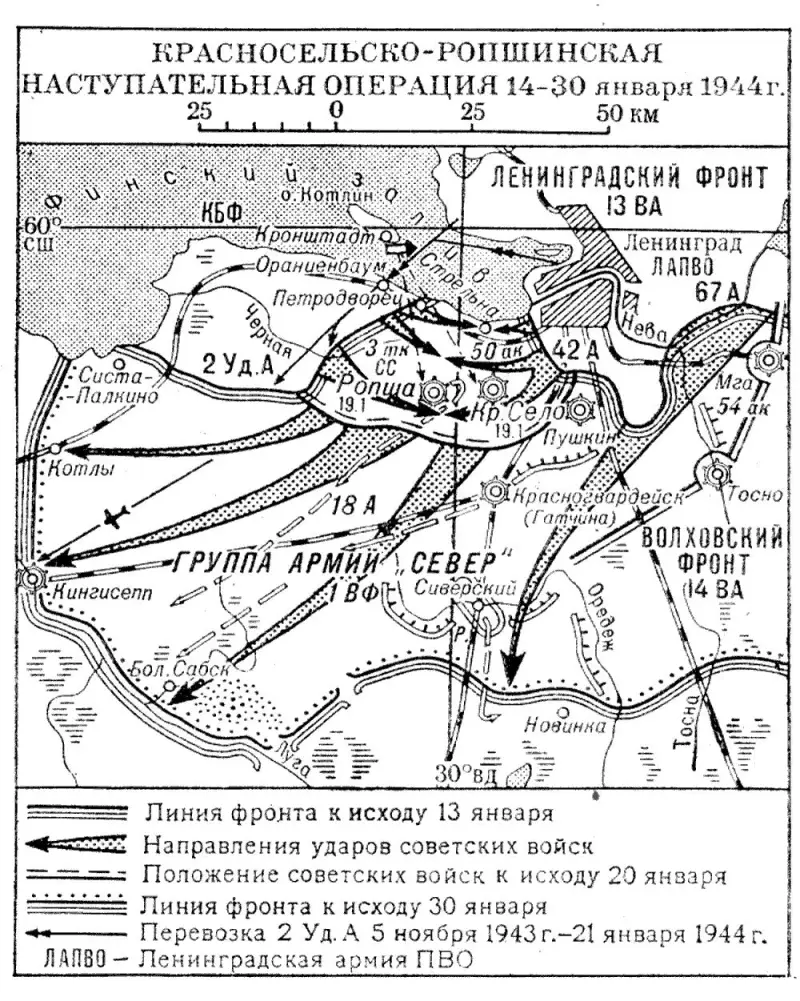
The German 50th Army Corps held back the advance of the 42nd Army. The mechanized units of Maslennikov's army, due to the large number of anti-tank ditches and minefields, as well as the effective fire of German artillery, suffered heavy losses and could not properly support the advance of the riflemen.
In three days of stubborn fighting, two Soviet armies bit into the enemy’s defenses no more than 10 km. The troops of the 2nd Shock Army and the 42nd Army did not have enough experience to break through the heavily fortified enemy defenses. Nevertheless, by the end of the third day, the troops of the 2nd Shock Army were able to break through the enemy’s main defensive line at the front up to 23 kilometers. Army commander Fedyuninsky formed a mobile group (152nd tank brigade and several rifle and artillery formations), which he led into the breakthrough. The mobile group received the task of capturing and holding Ropsha.
The commander of the 42nd Army also brought reserves and a mobile group into battle on January 17 (1st Leningrad Red Banner, 220th tank brigades and two self-propelled gun regiments). The mobile group received the task of liberating Krasnoye Selo, Dudergof and Voronya Gora.
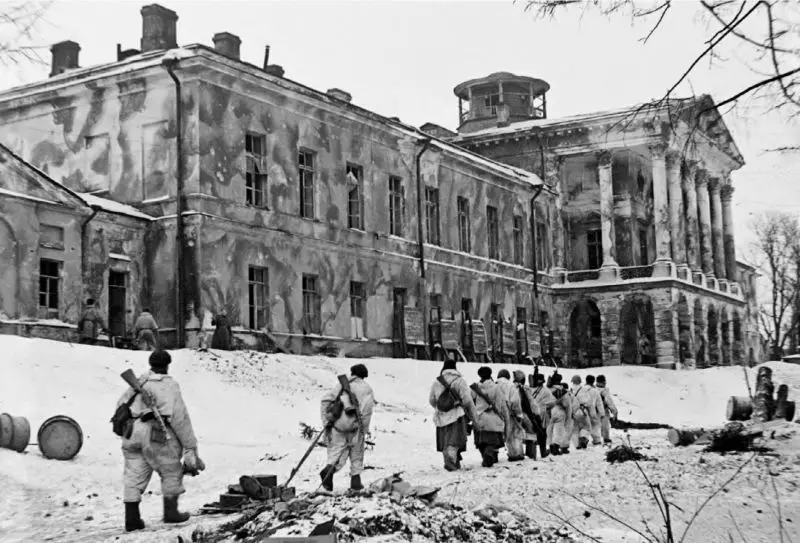
A unit of Soviet machine gunners walks past the Ropshinsky Palace in liberated Ropsha. January 19, 1944
The Germans began to run out of steam. They used all tactical reserves, and the operational reserve was the 61st Infantry Division. German troops in the areas of Krasnoe Selo, Ropsha and Strelnya were under threat of encirclement. The commander of Army Group North, Georg von Küchler, decided to withdraw parts of the 26th Army Corps from the Mginsky salient to help defend the Krasnoe Selo area. But the transfer of these troops could no longer change the situation.
On January 19, troops of two Soviet armies liberated Krasnoye Selo and Ropsha. On the same day, the troops of the two fronts united. But it was not possible to create a dense “cauldron”. The German command, taking advantage of the fact that there was no continuous front line yet, withdrew most of the troops from the encirclement area. On January 20, the remnants of the Peterhof-Strelny enemy group were destroyed. The Germans, retreating, abandoned heavy weapons and siege equipment, which had accumulated near Leningrad for years. Soviet troops captured 265 guns, including 85 heavy ones. The Nazis were thrown back 25 km from the second Soviet capital.
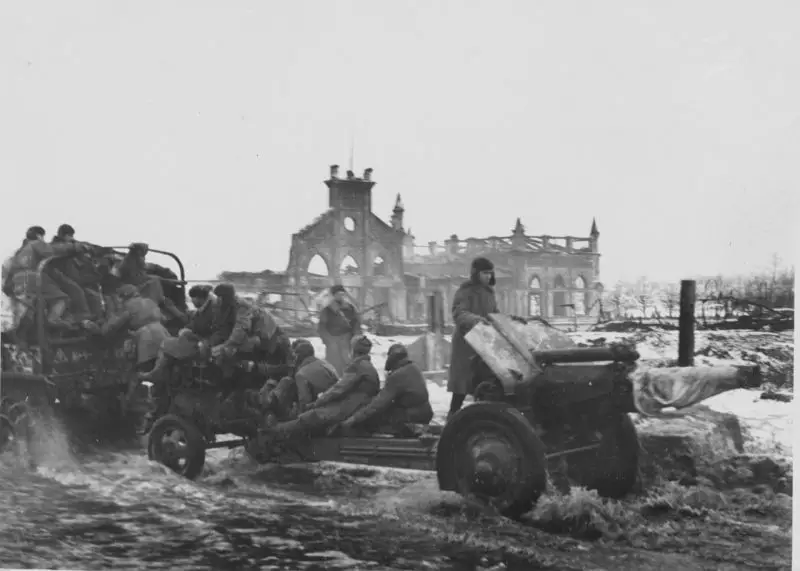
The truck is pulling a Soviet M-30 howitzer with soldiers on it. In the background is the destroyed Krasnoye Selo train station. January 1944
Offensive development
The defeat of the Peterhof-Strelna group and the successes of the VF, which also went on the offensive on January 14, created favorable conditions for the continuation of the offensive of the LF troops. Maslennikov’s army received an order to strike in the direction of Krasnogvardeysk, Pushkin and Tosno in order to go behind the forces of Army Group North, which held positions in the area of Ulyanovka, Mgi and Tosno.
Subsequently, the 42nd Army was supposed to defeat the 26th and 28th German Army Corps and, in cooperation with the forces of Sviridov’s 67th Army and the right wing of the VF, establish control over the October Railway and completely remove the encirclement from Leningrad. The forces of Fedyuninsky’s army were given the task of bypassing Krasnogvardeysk from the southwestern direction, facilitating the offensive of the 42nd Army.
On January 21, units of the 67 Army of the LF and the 8 Army of the VF, having discovered the withdrawal of the enemy’s MGNA group, launched an offensive. On the same day, Soviet troops liberated MGu. The Germans fought off the Kirov railway. However, they could not develop the offensive. The Nazis took up positions on the intermediate defensive line of the Autostrada along the October Railway and put up stubborn resistance.
The Germans' retreat from Mga forced the LF command to adjust their plans. Now the main task of the 2nd shock and 42nd armies was to attack Krasnogvardeysk, and then on Kingisepp and Narva. The 67th Army was supposed to occupy the Oktyabrskaya Railway and support the attack on Krasnogvardeysk.
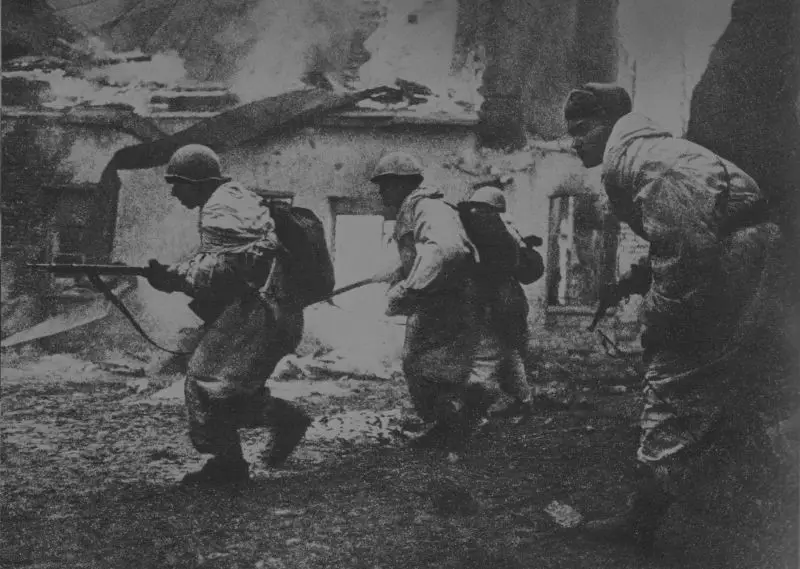
The soldiers of the battalion commander, Major Mikhail Matveevich Lebedenko, of the 538th Infantry Regiment of the 120th Infantry Division, who were the first to break into the city, are fighting for the liberation of Gatchina (Krasnogvardeysk). January 26, 1944
For several days there were stubborn battles on the Oktyabrskaya Railway line for Krasnogvardeisk, Pushkin and Slutsk. The Germans tried to hold Krasnogvardeysk at any cost. The commander of Army Group North deployed several formations to this area. Hitler refused to allow the withdrawal of troops from the Oktyabrskaya Railway line, from Pushkin and Slutsk.
On January 24, Pushkin and Slutsk were liberated. On January 25, a decisive assault on Krasnogvardeysk began. Fierce fighting lasted for almost a day. On January 26, Krasnogvardeysk was cleared of Nazis. The solid front of defense of the 18th German Army was broken through, the German divisions were retreating.
By January 2, the 30nd Shock Army reached the Luga River. On the night of February 1, Kingisepp was taken by storm. The Germans, unable to hold their position on Luga, retreated to the line on the Narva River. Units of the 42nd Army, developing an offensive in the southwestern direction, also reached Luga and occupied a bridgehead in the Bolshoi Sabsk area. The troops of the 67th Army under the command of Sviridov, overcoming strong enemy resistance, liberated Vyritskaya on January 27, and by January 30 they recaptured Siversky.
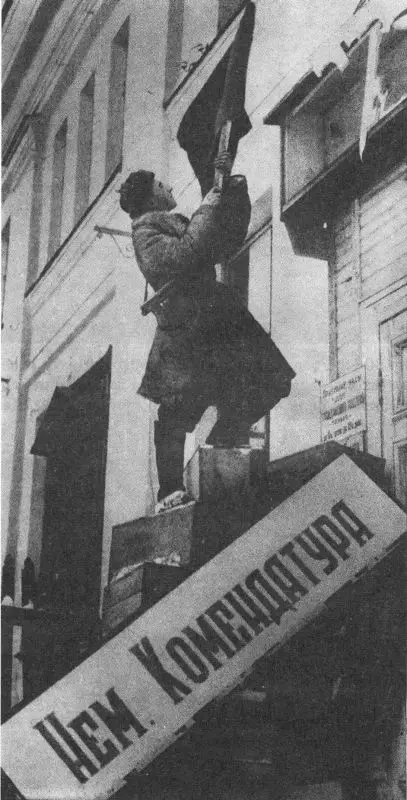
Reconnaissance shooter of the 269th separate reconnaissance company of the 189th Kingisepp Infantry Division, Red Army soldier Nikolai Petrovich Tsynoshkin, hoists a banner at the former German commandant’s office in liberated Kingisepp. February 1944
Thus, units of the Leningrad and Volkhov fronts, in cooperation with the Baltic Fleet, broke through the powerful enemy defenses and inflicted a heavy defeat on the 18th German Army. Soviet soldiers finally liberated Leningrad and advanced 70-100 km. On January 27, a ceremonial fireworks display was made in Leningrad and Moscow in honor of the final liquidation of the blockade of the northern capital of the USSR. Three hundred and twenty-four guns fired in honor of the great victory. Leningraders rejoiced: the terrible blockade, which claimed thousands of lives, was a thing of the past.
True, it must be remembered that the Finnish army was still stationed in the northern sector of Leningrad. It still had to be defeated and thrown back from the most important Soviet center.
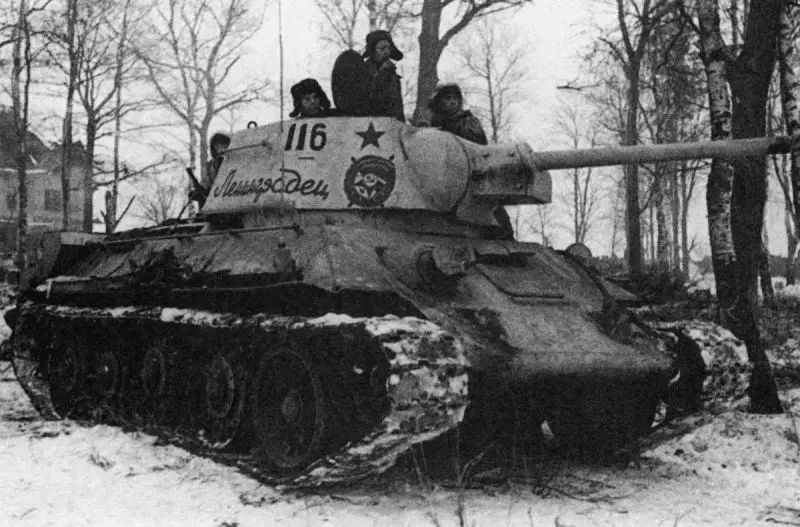
Soviet tank T-34 "Leningradets" of the 30th Guards Tank Brigade of the 67th Army of the Leningrad Front enters Krasnoye Selo
Information